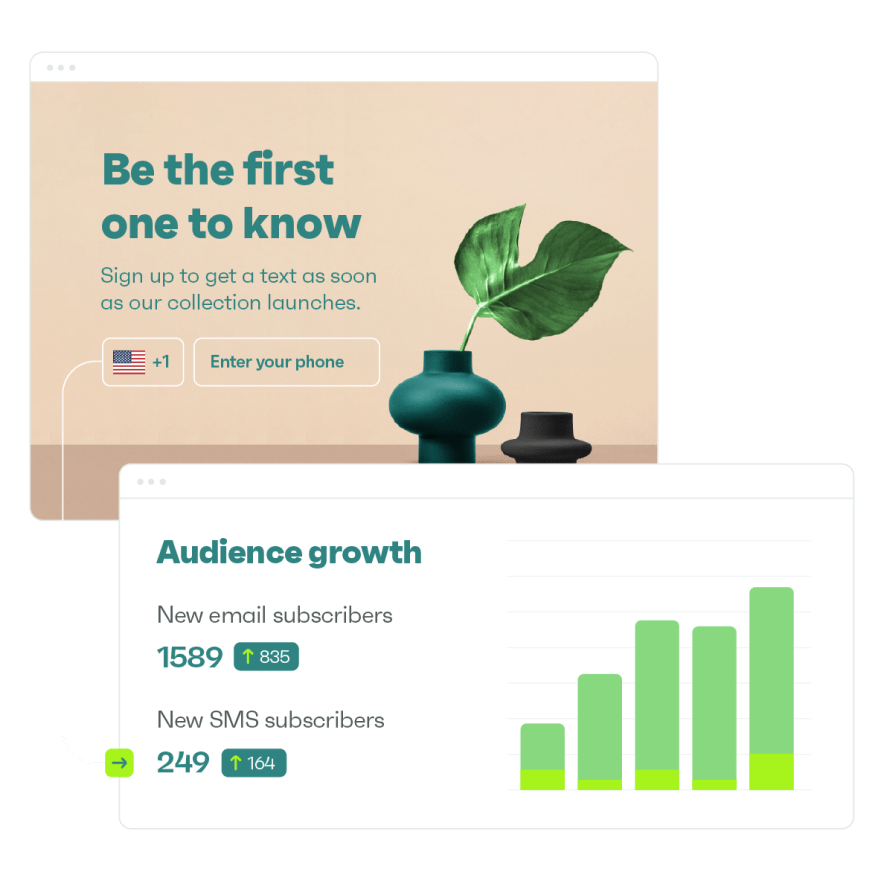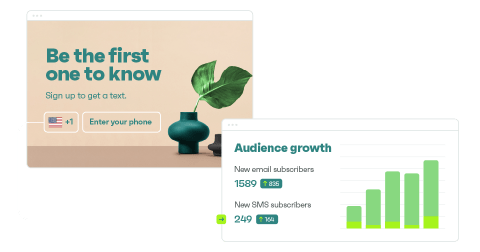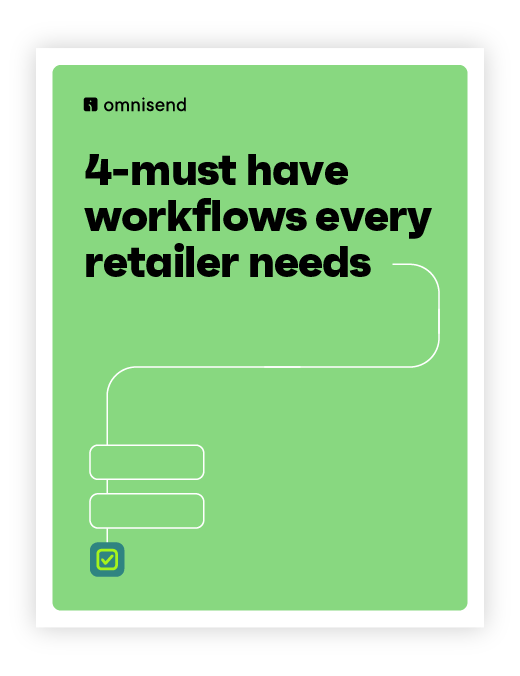Drive sales on autopilot with ecommerce-focused features
See FeaturesEcommerce personalization: A beginner’s guide [10+ examples]
Many people think that ecommerce personalization is limited to customizing subject lines, using a customer’s first name, or sending abandoned cart reminders.
The reality is that these techniques are just the tip of the iceberg as far as personalization is concerned. Ecommerce personalization is far more sophisticated, tailored, and impactful. The possibilities are endless.
In this easy-to-digest guide, we’ll explain the concept of ecommerce personalization and its benefits. We’ll also analyze interesting examples and share actionable tips to help you include personalization in your ecommerce marketing.
In this post:
- What is personalization in ecommerce?
- Benefits of personalization in ecommerce
- How to collect data for ecommerce personalization
- What can you personalize in ecommerce?
- Ecommerce personalization examples
- Final thoughts
Personalize your email & SMS ecommerce marketing and elevate your brand with powerful targeting, customer lifecycle maps, and retargeting.
What is personalization in ecommerce?
Ecommerce personalization tailors shoppers’ online experience to their interests, preferences, and purchase history. This can include customizing product recommendations, offers, web content, and messaging. Customers then have a relevant, personalized shopping journey as they discover and buy products.
Done well, personalization helps brands build stronger customer relationships. Customers receive product suggestions and content that speak directly to their needs. Their personalized ecommerce experience leads to higher satisfaction and engagement over time, boosting conversions and revenue.
Benefits of personalization in ecommerce
Good ecommerce personalization can help you reach your potential customers and connect with them in a way that drives more engagement and conversions. The great thing about personalization is that it isn’t one-sided—personalization has benefits for both the buyer and the ecommerce retailer.
When used correctly, personalization in ecommerce has the following benefits for both parties:
- Tailored content and offers. Buyers directly receive personalized content, relevant product recommendations, and exclusive offers.
- Enhanced product discovery. Ecommerce personalization introduces buyers to new products matching their needs and preferences.
- Reduced cart abandonment. With personalized automated emails acting as timely reminders, buyers can complete purchases for specific items they left behind.
- Improved customer experience. Personalization facilitates seamless and customized interactions at every stage of the buyer journey, enhancing satisfaction and loyalty.
- Attention-capturing content. It can help you capture buyers’ attention by delivering content tailored to their interests.
- Simplified decision-making. You can mitigate information overload and analysis paralysis by presenting buyers with precisely what they seek, eliminating the burden of sifting through excessive choices.
- Increased loyalty and sales. By consistently meeting individual needs, personalization enhances connection, builds customer loyalty, and drives sales.
How to collect data for ecommerce personalization
The first step towards mastering ecommerce personalization is collecting consumer data. You need to understand the different types of customers that you have and understand what drives their purchase decisions.
The key to ecommerce personalization is providing tailored marketing, messages, and offers to different types of customers. Audience research and data collection can make that possible.
Here are some tips to collect consumer data for ecommerce personalization:
- Website analytics. Use analytics to reveal site visitors’ behavior, interests, and needs. You can also learn customer demographics, location, device usage, page views, time spent on site, and more.
- Email marketing software. Platforms like Omnisend provide comprehensive insights, including open and click rates. Use them to also reveal campaign engagement, optimal sending times, and subscriber preferences.
- Purchase data. Past sales transactions can help you understand customer interests and price sensitivity. Purchase history can also help you learn their channel preferences and frequency of purchases.
- Website popups. Popups can help capture customer product preferences and feedback on the shopping experience. They can also provide insights on what incentives (e.g. discounts, free shipping, or gifts) work best to encourage signups.
- Social media engagement. Monitor social media interactions to understand customer sentiment, preferences, and behaviors. This data provides insights into pain points, trending products, feedback, and the effectiveness of your brand messaging.
- User-generated content (UGC). UGC like reviews, testimonials, and Q&As can be a rich source of authentic insights. Use it to learn interests, values, and the language used by your target audience.
There’s no shortage of channels you can use today to collect customer data. However, the key is unifying insights across sources to get a 360-degree view of each shopper. Without a cohesive personalization strategy tying everything together, efforts are more likely to be disjointed and inconsistent.
Achieving true customer-first status requires seamless integration of insights. This ensures the harmonization of every aspect of the customer experience. The result is more meaningful connections and sustained business success.
 | “Some are great with personalizing advertising, some with customer service, some with product development. But very few have the foundations in place to piece all of this together to transition to being customer first as opposed to customer-centric.” Phil Irvine, Vice President, Audience Intelligence at RPA Read the full interview |
What can you personalize in ecommerce?
Ecommerce personalization goes far beyond promotional emails. Done right, it creates a fully customized shopping experience tailored to each individual.
- Abandoned cart messaging. This sends customers a message that encourages them to complete purchases.
- Popups. These allow for delivering different promotional messages to new versus returning visitors. First-timers may see a signup offer, while loyal customers get VIP discounts.
- Post-purchase emails. Use post-purchase emails to thank customers and offer suggestions for complementary products. They help steer momentum into additional sales.
- Transactional emails. Send transactional emails to confirm purchases, shipping status, and so on. You can even include upsell offers. These can be personalized product recommendations based on recent orders.
- Product recommendations. Tailor these to customer needs and preferences using quizzes and surveys. Ask relevant questions, then show personalized recommendations based on answers.
- Upsells and cross-sells. These are an effective way to increase order value and customer satisfaction. Use them to encourage customers to add more items once they make a purchase.
- Reorder reminders. Ideal for subscription businesses, they can help customers replenish staple products right on schedule. When personalized, they optimize customer satisfaction and loyalty.
- Homepage and product content. Consider featuring dynamic elements in this content. You can personalize with suggested or related purchases for each visitor.
Ecommerce personalization examples
Let’s run through some real examples of where ecommerce personalization is working well and see if you can take any inspiration from some of the best ecommerce personalization examples around:
- Personalized website popups (B-Wear)
- Abandoned cart reminder email messages (Amundsen Sports)
- Facebook retargeting ads (Amundsen Sports)
- Marketing offers for inactive subscribers (Island Olive Oil Company)
- Product discovery quizzes (Jack Mason)
- Targeted SMS campaigns (Divatress)
- Push notifications with related products (H&M)
- Instagram retargeting ads (Tropic Feel)
- Personalized product recommendations (Sephora)
- Marketing messages on website checkout (Taylor Stitch)
- Geo-targeted social media ads (Volvo Poland)
- Dynamic content on store pages (ASOS)
1. Personalized website popups (B-Wear)
Personalized popups allow ecommerce brands to deliver tailored messaging to website visitors.
For example, B-Wear uses popups to target first-time site visitors with a 15% off coupon. This provides an immediate incentive to explore products and make a purchase.
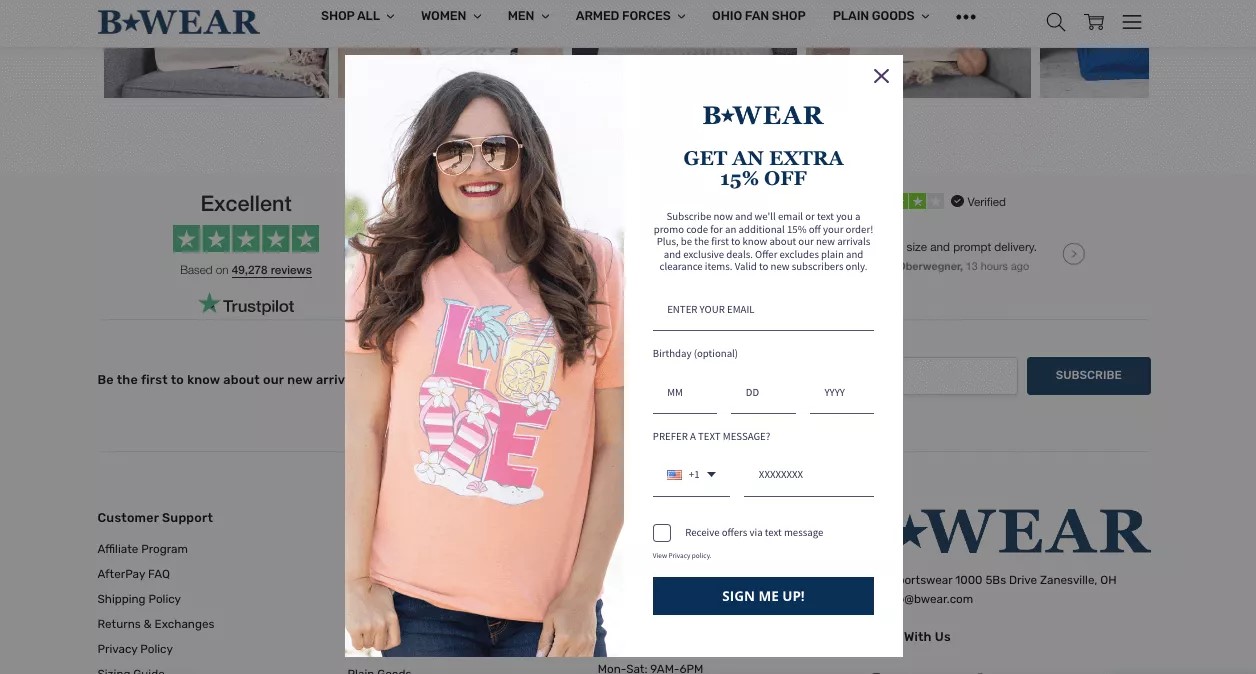
Creating personalized popups is easy with advanced targeting options. Platforms like Omnisend let you create popups that appear or don’t appear on specific URLs, or that appear on pages for out-of-stock products. You can also choose who sees the popups. These can be all visitors, existing contacts, or new visitors only.
Such targeting options help you tailor popups to different visitor segments. You can offer them relevant content and offers in the process. With a few clicks, your popups can zero in on different visitor segments.
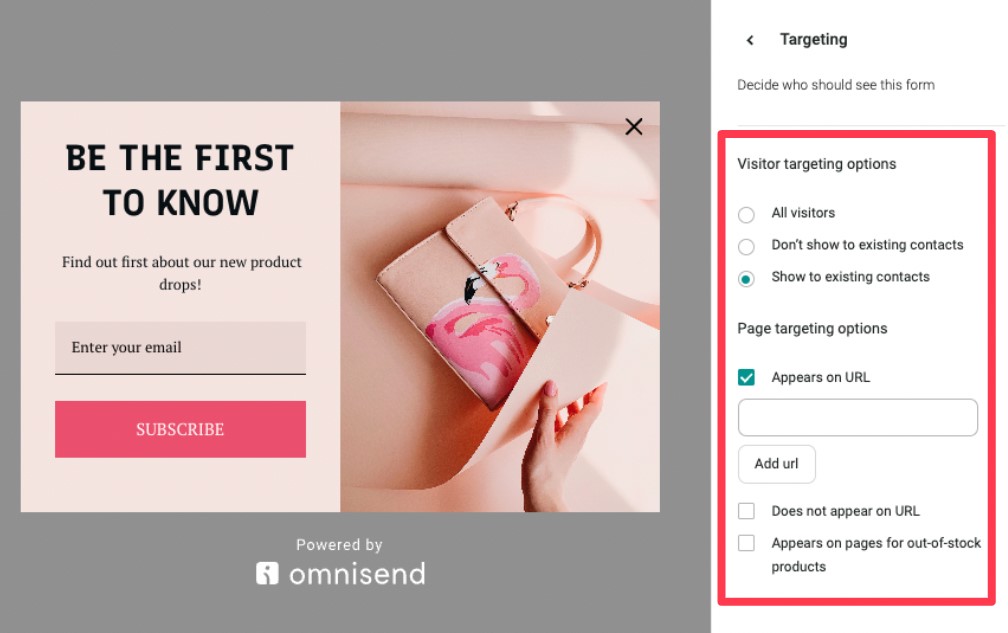
Creating and optimizing popups and signup forms can help take your visitor experience to the next level. Here’s a video explaining how to easily do it on Omnisend.
2. Abandoned cart reminder email messages (Amundsen Sports)
Abandoned cart reminders re-engage potential customers who left items in their virtual carts. They remind you of the value and benefits of your products and encourage shoppers to complete their purchase.
A great example of this strategy is Amundsen Sports, which uses Omnisend to create and send beautiful and engaging emails. Check out its series of two emails to customers who abandon their emails. The first email is “Enjoying the mountains?” while the second is “Still thinking about it?”
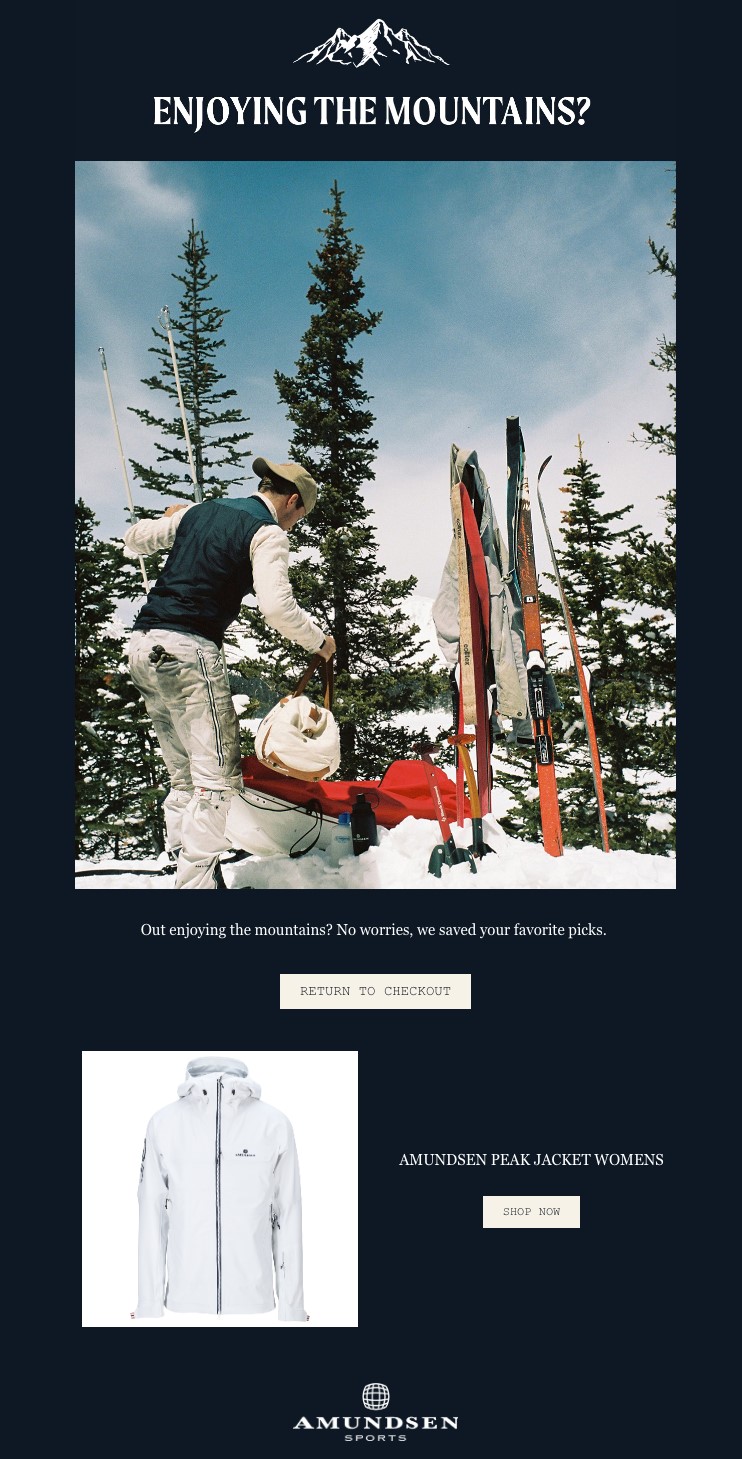 | 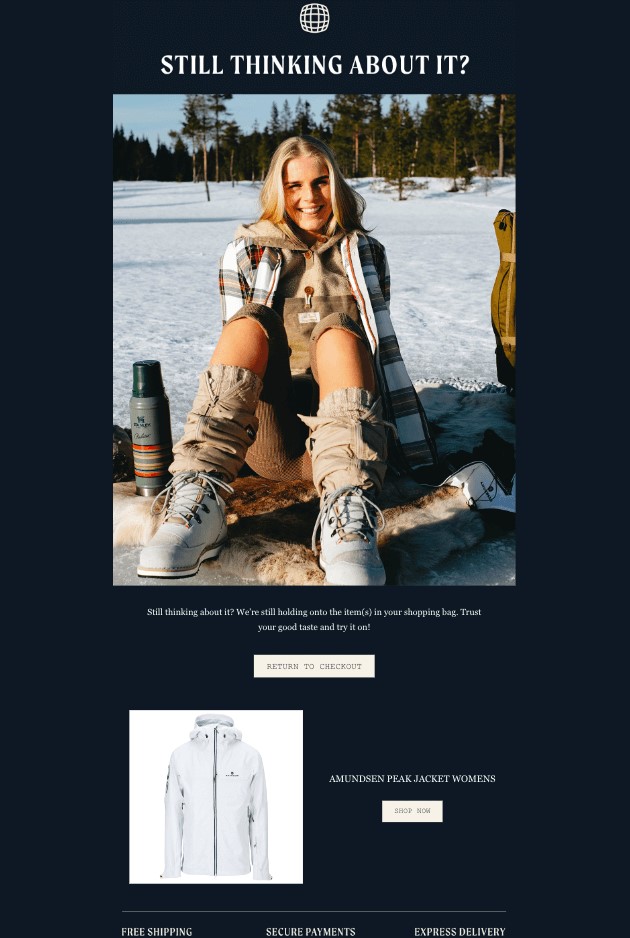 |
This simple, personalized automation drove a 57% conversion rate even without a discount. It delivered over 1,500% more revenue per email than promotions, accounting for 10.8% of Omnisend revenue from just 0.9% of sends.
Check out Amundsen’s case study for more on their tactics for irresistible cart reminders.
Additionally, if you’re eager to learn more about setting up effective cart abandonment emails, check out our insightful video guide:
3. Facebook retargeting ads (Amundsen Sports)
Facebook retargeting allows brands to serve personalized ads to customers based on their site behavior.
Amundsen Sports syncs their U.S. customer segment from Omnisend into Facebook ads. When a popular product comes back in stock, the company can re-engage high-intent visitors.
For example, when 5MILA Half Zip was restocked with new colors, Amundsen created Facebook ads announcing its availability. It aimed these ads at those who’d recently viewed the sold-out product.
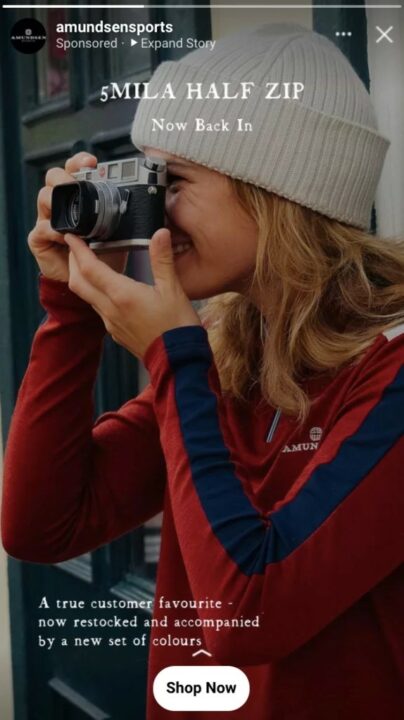
Retargeting high-demand products helps turn interested visitors into buyers. Combined with tailored email campaigns, this strategy provides a personalized experience across channels. Customers feel valued when brands remember their preferences. Further, it helps rekindle interest when they’re notified of desired product availability.
Omnisend makes it easy to sync engaged segments for coordinated email and Facebook ad personalization. Together, these tactics boost customer satisfaction and repeat purchases.
4. Marketing offers for inactive subscribers (Island Olive Oil Company)
Island Olive Oil Company uses ecommerce personalization ingeniously by targeting at-risk customers. With Omnisend’s customer lifecycle map, it can identify subscribers who haven’t purchased in awhile. Then, it re-engages them by sending special deals like this “375ML Bottle Sale” email.
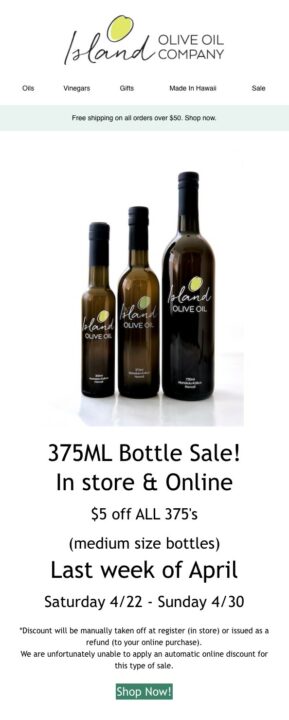
Segmenting the customer journey by lifecycle stages allows Island Olive Oil Company to optimize its marketing like an enterprise brand.
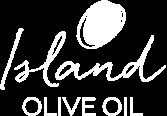 | “The lifecycle stage map is an incredible opportunity for a small business. This is the kind of thing that, otherwise, takes a marketing team to be able to do. It’s a simple way to see our customers’ shopping or purchasing habits in one place, and it’s really helped us to be able to target different groups. We’re competing with larger businesses, and this allows us to have that reach at the right time.” Angèl Foster, a Co-Owner of Island Olive Oil Company Read the case study. |
Discover how Omnisend’s customer lifecycle map lets you easily identify subscriber segments based on purchase frequency and more. Personalized outreach helps reactivate customers and boost subscriber lifetime value.
5. Product discovery quizzes (Jack Mason)
Product discovery quizzes allow ecommerce brands to recommend products matched to customer preferences. They’re interactive tools that ask your visitors a series of questions, then recommend products based on the answers.
In addition to collecting valuable data about your customers’ preferences and needs, quizzes can help increase conversions and reduce returns. A good example of a product discovery quiz is from Jack Mason, a brand that sells watches and accessories:
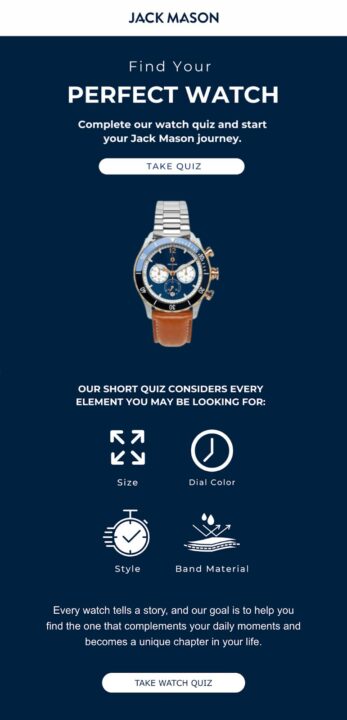
This quiz asks about the size, style, dial color, and band material of the watch that subscribers are looking for. It then shows a selection of matching products. This makes it easier for customers to discover relevant styles that reflect personal taste, while allowing Jack Mason to showcase its product range.
For tips on creating compelling, effective email newsletters, see our email newsletter design guide.
6. Targeted SMS campaigns (Divatress)
SMS marketing allows ecommerce brands to reach customers on the go. The best part? You can personalize it to send targeted messages to announce flash sales and promotions. Here’s an example of Divatress’ SMS marketing automation at work:
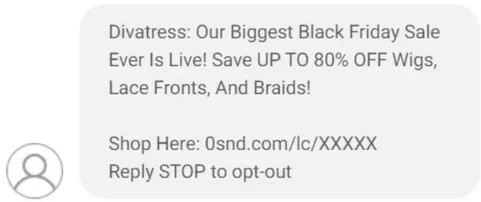
With opt-in subscribers primed to buy, SMS delivers exceptional open and conversion rates compared to email. Additionally, customers appreciate getting VIP access to deals and new arrivals via text. There’s no question that SMS marketing has a positive impact on customer loyalty, especially as it helps boost ecommerce sales.
 | “At this point, I can’t imagine a world without SMS marketing. It’s really taken off. Our SMS subscribers are growing much faster than email subscribers. Over the first year, SMS campaigns drove $123,000 in sales.” Rob Lin, CEO Divatress |
Read Divatress’ case study for a deeper dive into how it integrates SMS into its marketing strategy with Omnisend.
7. Push notifications with related products (H&M)
Ecommerce brands use push notifications to reach customers on their mobile devices with timely, relevant messages. This can help increase engagement, loyalty, and sales. Pushes achieve this by showing relevant offers based on previous purchases or browsing behavior.
For example, H&M sends push messages to customers who bought a jacket, suggesting matching boots to complete their look.
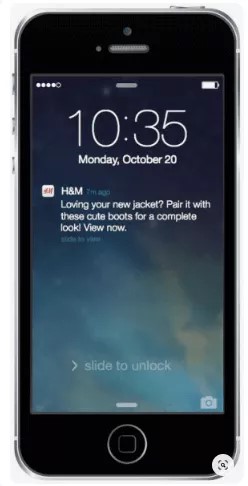
This is a smart way to cross-sell products that the customer might be interested in.
Pushes like this showcase complementary products, encouraging further shopping. The customized recommendations feel helpful rather than intrusive. While many associate pushes with operational alerts, they’re highly effective for personalization too.
You can pair products from recent orders, promote items left in carts, announce flash sales, and more. With advanced behavioral segmentation, you can target pushes to user groups based on their behaviors and preferences.
For more tips, use cases, and strategies, check out these push notification examples.
8. Instagram retargeting ads (Tropic Feel)
Instagram ads let brands reconnect with previously interested customers. A noteworthy example is the travel gear brand Tropic Feel’s ad for the Nest Backpack. It’s strategically shown to users who clicked on a similar product from a competitor.
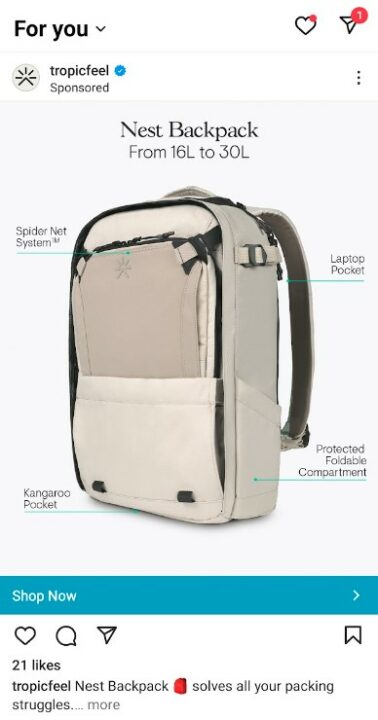
Retargeting warm prospects with relevant offers provides a personalized experience across channels. When precise, retargeting also captures potential customers’ attention. Furthermore, Instagram’s visual nature makes it ideal for brands wanting to showcase products.
For more information, Omnisend provides tips on using Instagram for ecommerce. A helpful guide on making money on Instagram is also available.
9. Personalized product recommendations (Sephora)
When you’re adding products to your website, you can usually select complementary products to cross-sell and upsell to customers. It might be a matching set or something that will help you to use the product you’re currently adding to your basket.
Retailer Target does an excellent job with ecommerce site personalization—if you search TVs on a desktop, you’ll get results for a matching stand or wall mount as a “frequently bought together recommendation.” Beauty brand Sephora has a slightly different approach.
It shows similar products to prospective customers and also provides the option to compare products. This takes ecommerce personalization through product recommendations a notch higher.
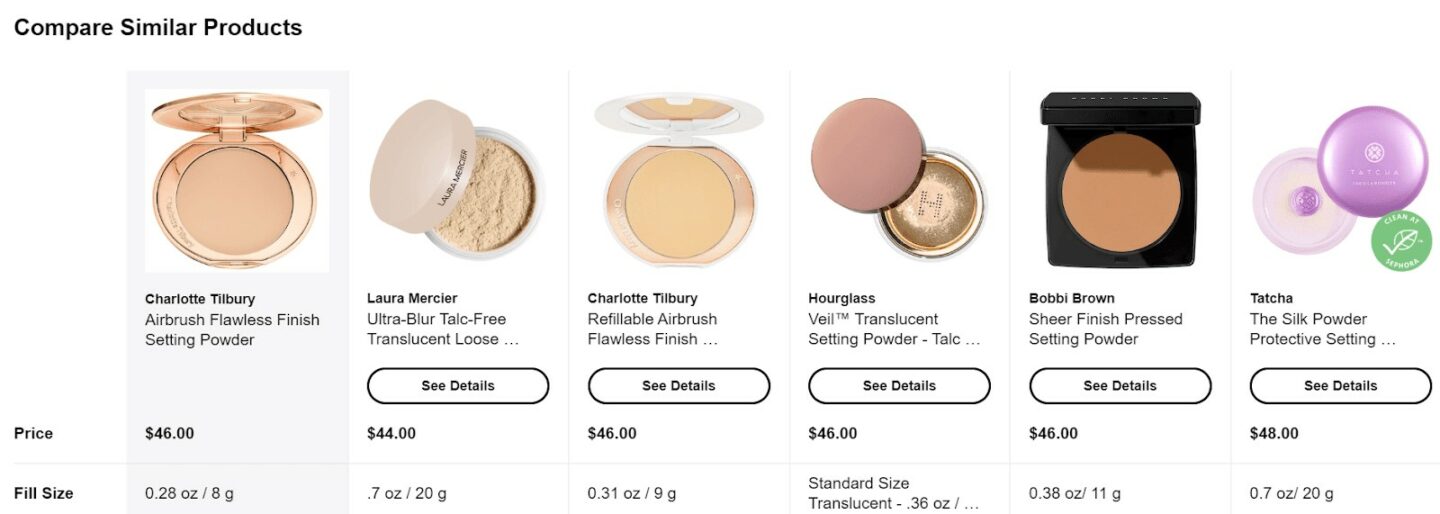
Here are some more details on how to use product recommendations on your ecommerce site so that your recommendations make sense, are useful to the customer, and, most importantly of all, that they convert to more sales.
10. Marketing messages on website checkout (Taylor Stitch)
The checkout process presents prime real estate for personalized promotions. Apparel company Taylor Stitch adds relevant upsell offers within the checkout flow. For example, it suggests complementary products like a heavy bag tee under a “Top It Off“ message:
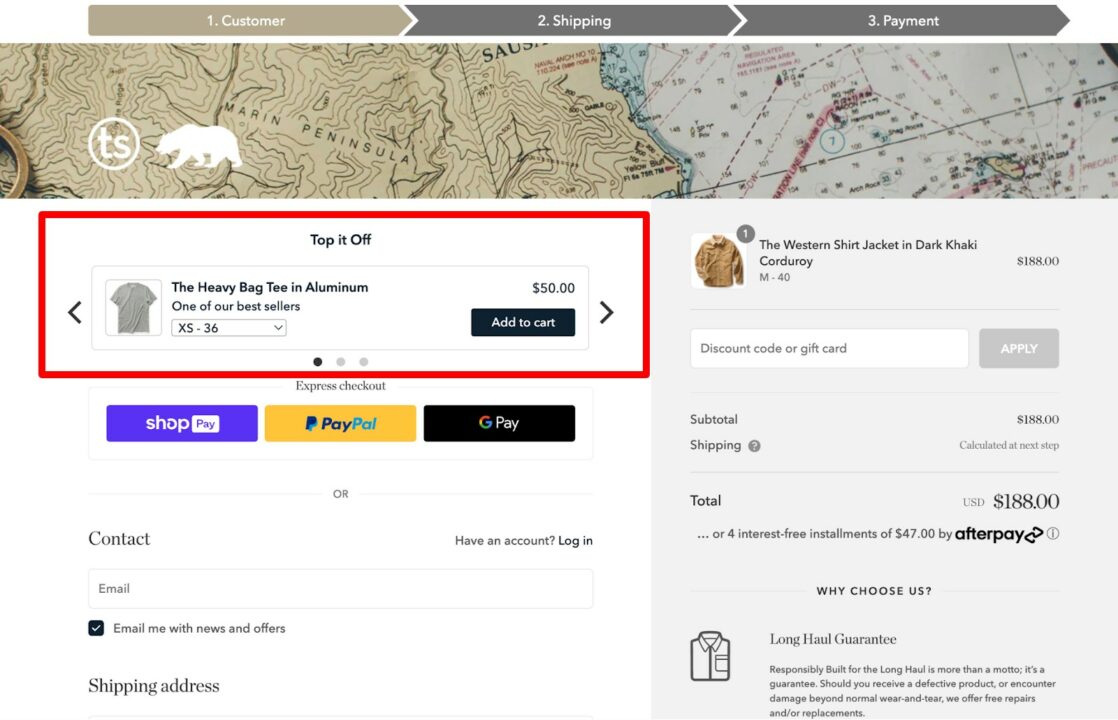
Customizing the checkout experience makes it feel like transactions are being hand-tailored, even at scale. Personalized elements you can add to checkouts include:
- Dynamic upsell recommendations based on cart contents
- Customer-specific discounts or free shipping eligibility
- Reorder reminders for frequently purchased products
- Bundle offers, such as “Buy one get one free” or “Save 10% when you buy these items together”
- Customer reviews, ratings, or testimonials for the products in the cart for reference
11. Geo-targeted social media ads (Volvo Poland)
Localizing social ads is an impactful ecommerce personalization tactic. Geo-targeted ads show different content or offers based on the location of the user.
For example, Volvo Poland used geo-targeted ads on Facebook and Instagram to promote their cars to potential customers in Poland. Ads were tailored to the local language, culture, and preferences of the Polish market.
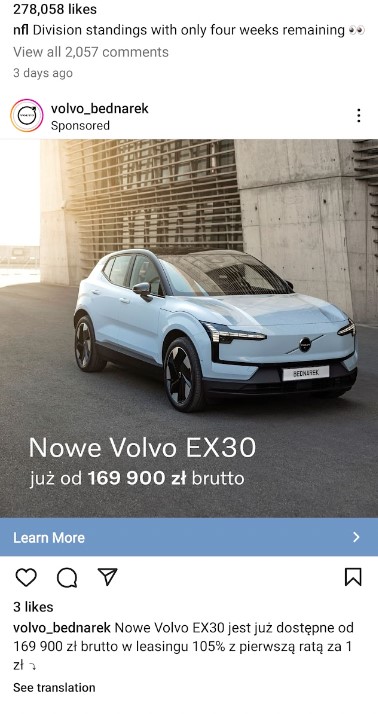
By harnessing geo-targeting, Volvo Poland enhances the relevance of their campaigns. It also demonstrates a commitment to providing a personalized and locally tailored experience for its customers.
This strategy not only boosts engagement but also contributes to a stronger brand-consumer connection in the region.
12. Dynamic content on store pages (ASOS)
Online clothing retailer ASOS is split by gender and product type (as well as location). Their site remembers how you last looked at the site and automatically drops you back into the category that best suits your interests.
In the example below, you see a gender-neutral home page, but after you’ve shown interest in women’s clothing, the homepage shows a page focused on women’s clothing:

Ecommerce product personalization like this is tough to achieve, but still possible.
This can be done by taking into account demographic information like gender and location when you segment your buyers, and also by correlating with purchase and visit data. Tools like Google Optimize, Dynamic Yield, Personyze, and Adobe Target can help with ecommerce site personalization.
Final thoughts
Ecommerce personalization is a big deal when it comes to engaging visitors, building up a relationship with your customers and converting sales, whether that’s through personalized ecommerce email, product upselling, or abandoned cart emails.
It makes a real difference to customers, who value ecommerce personalization in a big way, and can even help you to attract visitors to your site by boosting where you sit in search results.
It doesn’t have to be tons of extra effort either—you can automate your personalization with Omnisend, so once it’s set up you can sit back and see the benefits, like thousands of other ecommerce stores we’ve worked with to help develop personalized online shopping.
quick links
related features
No fluff, no spam, no corporate filler. Just a friendly letter, twice a month.
